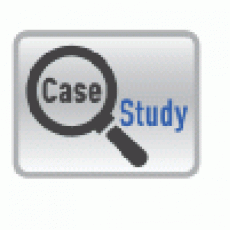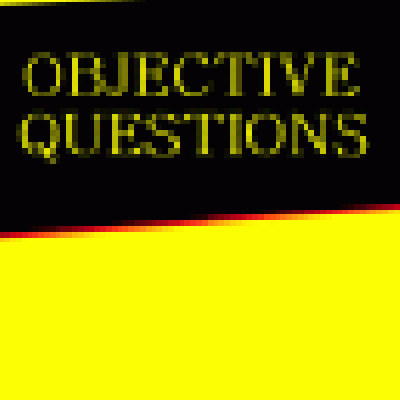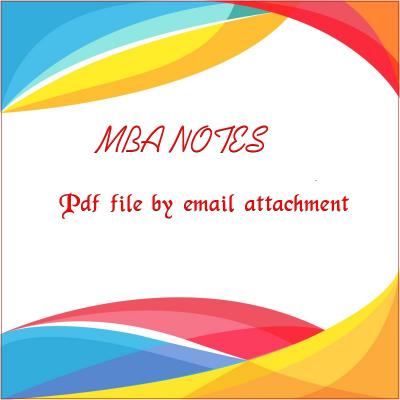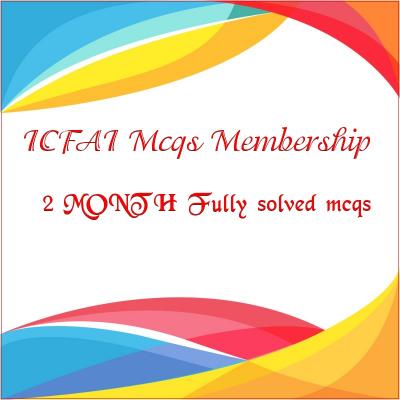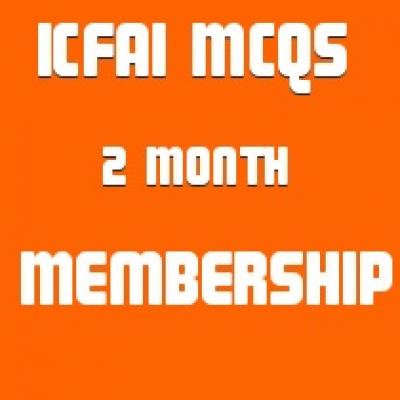CORPORATE GOVERNANCE
Price:
Rs500
Q1. In the second version of McKinsey’s model called “the Central model” governance chain is represented by
a. Well-developed equity market & dispersed ownership
b. Underdeveloped equity market & concentrated ownership
c. Well-developed equity market & concentrated ownership
d. Underdeveloped equity market & dispersed ownership
Q2. Corporate governance refers to a combination of law, rules, regulations and
a. Value
b. Wealth
c. Voluntary practices
d. Customer Satisfaction
Q3. ____________, is one of the major tools. Corporations use to direct persuasive communication to
target buyers & the public.
a. Advertising
b. Media
c. Press
d. None
Q4. Policy adopted by the monetary authority with respect to the supply of money is called
a. Monetary Policy
b. Fiscal Policy
c. Budgetary Policy
d. Economic Policy
Q5. Cash reserve requirements refer to the
a. Purchase & Sale of government securities & other approved securities by the Central bank.
b. Changes in bank rate by the Central Bank
c. That portion of bank’s total cash reserves which they are statutorily required to hold with the
RBI.
d. The particular level of liquid ity maintained by commercial banks.
Q6. This committee was set up in January 1995 to identify good practices by the confederation of
British Industry (CBI)
a. The Paul Ruthman Committee
b. The Greenbury Committee, 1995
c. Cadbury Committee, 1995
d. The Hampel Committee,1995
Q7. ______________, plays a significant role in the growth of the corporate sector by providing them
finance for their Operations.
a. Investors
b. Bank
c. Organization
d. None
Q8. The first stock market scam was one which involved both the bond and equity markets in India.
a. MNC’s efforts at Consolidation of ownership, 1993
b. Vanishing Companies Scam, 1993-94
c. M. S. Shoes, 1994
d. Harshad Mehta scam, 1992
Q9. Debt purchasers provide finance in return for a promised stream of payments & a variety of other covenants pertaining to corporate behavior, such as the value and risk of corporate assets. These are called
a. Concentrated Debt
b. Diffused Debt
c. Creditor Incentives
d. Debt Collection
Q10. A person having control over the direction, conduct, management or superintendence of then affairs of a company is called
a. Director
b. Co- director
c. Board members
d. None
Q11. A director who is not duly appointed but acts as a director is known as a
a. Fraudulent Person
b. De Facto
c. De Jure
d. None
Q12. This type of auditors are usually referred to as a CPA (Certified Public Accountants) firms
a. Internal auditors
b. Independent auditors
c. Government auditors
d. None
Q13. To introduce corporate governance practices in the banking sector the recommendations of the working group of directors of financial Institutions known as the
a. Ganguly Group
b. Policy Implication
c. Government Control
d. Withdrawal effects
Q14. It is a manipulative method where one buy the power or the influence of others persons in order to satisfy his selfish need.
a. Coercion
b. Tax Evasion
c. Bribery
d. Insider Trading
Q15. This model supports the idea of multiple interests of stakeholders rather than shareholders interest alone
a. The Social Entity Theory
b. Trusteeship Model
c. The Pluralistic Model
d. Social Responsibility
Q16. This policy was released in August by the Ministry of Environment & Forests (MOEF) for Public discussion
a. The National Environment Policy, 2004
b. Draft Policy
c. Biodiversity Conservation
d. Forest & wildlife Conservation
Q17. Out of the following which Committee appointed to examine all current Capital market regulations & to suggest amendments to them
a. SEBI
b. Dhanuka Committee
c. Primary Market Reforms
d. None
Q18. Out of the following which one sentence is the true
a. It lays down the framework for creating long-term trust between companies & the external provides of capital
b. It rationalizes the management and monitoring of risks a firm faces globally
c. It does not limits the liability of the top management 7 directors by carefully articulating the
decision making process
d. It never ensures the integrity of financial reports.
Q19. Out of the following which is the responsibility of an Auditor
a. Whether loans & advances made by the company on the basis of security have been properly secured.
b. Whether loans & advances made by the company have been shown as deposits.
c. Whether personal expenses have been charged to revenue account
d. He has to ensure that his work involves exercise of judgment.
Q20. This theory assumes that managers are basically trustworthy and attach significant value to their own personal reputation
a. Agency Theory
b. Stewardship Theory
c. Stakeholder Approaches
d. Sociological Theory
Q18. Out of the following which one sentence is the true
a. It lays down the framework for creating long-term trust between companies & the external provides of capital
b. It rationalizes the management and monitoring of risks a firm faces globally
c. It does not limits the liability of the top management 7 directors by carefully articulating the
decision making process
d. It never ensures the integrity of financial reports.
Q19. Out of the following which is the responsibility of an Auditor
a. Whether loans & advances made by the company on the basis of security have been properly secured.
b. Whether loans & advances made by the company have been shown as deposits.
c. Whether personal expenses have been charged to revenue account
d. He has to ensure that his work involves exercise of judgment.
Q20. This theory assumes that managers are basically trustworthy and attach significant value to their own personal reputation
a. Agency Theory
b. Stewardship Theory
c. Stakeholder Approaches
d. Sociological Theory
Q18. Out of the following which one sentence is the true
a. It lays down the framework for creating long-term trust between companies & the external provides of capital
b. It rationalizes the management and monitoring of risks a firm faces globally
c. It does not limits the liability of the top management 7 directors by carefully articulating the
decision making process
d. It never ensures the integrity of financial reports.
Q19. Out of the following which is the responsibility of an Auditor
a. Whether loans & advances made by the company on the basis of security have been properly secured.
b. Whether loans & advances made by the company have been shown as deposits.
c. Whether personal expenses have been charged to revenue account
d. He has to ensure that his work involves exercise of judgment.
Q20. This theory assumes that managers are basically trustworthy and attach significant value to their own personal reputation
a. Agency Theory
b. Stewardship Theory
c. Stakeholder Approaches
d. Sociological Theory
-
What is clause 49?
-
Explain Board of Directors & Corporate Governance?
1. Banks are also using concept of Corporate Governance. Explain why Corporate Governance is widely used in Banks. Also state few sound Corporate Governance Practices.
-
What is ethics & state why ethics is necessary in Business and also state the importance and need of business ethics?
1. Case study solved answers
2. pdf/word
3. Fully Solved with answers
